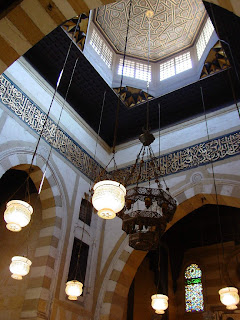Louis Werner
In the Miniature Painting Department of Pakistan’s National College of Arts (NCA), here, in a two-year intensive program that is a kind of modern karkhana, or Mughal painting workshop, students learn meticulous techniques, including ultra fine figure drawing and brushwork, tea staining of page borders and burnishing of paper surfaces—as well as how to work with such centuries-old materials as brushes made of squirrel-tail hair; handmade, multi-layered paper called wasli; and mussel-shell paint pots. Later, they give their imagination free rein to create new possibilities and new meanings for this highly disciplined tradition, in the context of a contemporary art world where few rules still seem to apply.
The NCA is now Pakistan’s premier institution granting Bachelor of Fine Arts degrees, and annually some 20,000 applicants seek one of its 150 admission slots; of these, only a dozen or so are chosen for the miniature-painting major.
Qureshi explains that it takes a special sort of student to major in miniatures, as opposed to, say, studio painting or printmaking. First of all, miniature painters sit on the floor all day, holding their paper up close to their eyes, bracing their painting arm against the body. “The hand becomes the palette, shells the mixing bowls. The floor replaces the stool, and the lap becomes the easel,” he says.
Minute, repetitive brush strokes render delicate figures in a painstaking technique called pardakht, a kind of linear pointillisme. It’s a far cry from the drips and splashes tossed about by the easel painters in the studio next door. Except for a faint bleeding of sound from students’ iPods, silence reigns in the miniatures room. Miniaturists choose their genre for reasons that derive from their personalities.
As Shahzia Sikander said at her 2001 Asia Society show in New York, a time when she was working in a more traditional vein, “the entire notion of ‘copying’ needs to be clarified.” Is it, she continued, “understanding the process, or is it understanding the lineage of the medium, or is it mere appropriation? Copying can also mean understanding history. One has to look at someone else’s work very carefully before relating to it in a personal way, in the same sense as claiming a historical past.”
Only in Pakistan does one find radical innovators like Qureshi painting oversize “miniatures” directly onto the walls of museums, or works like Rubaba Haider’s 2008 senior thesis, a piece she calls mader-e-gul (“My mother, the flower”): an installation of 35 paintings in small, round frames hung from the ceiling waist-high in a walk-through maze, each painting an image conjured from her own emotional responses to her mother’s stomach surgery.
As wildly creative as NCA miniaturists are invited to become by the time they graduate, their first full year of study is dedicated to the mastery of technique.
Teachers Waseem Ahmed and Naheed Fakhruddin, both NCA graduates themselves, oversee their 13 students’ progress not only in pardakht, but also in tappiai, or background color application; layee, or flour-glue paper surfacing and burnishing; and siah qalam, or black-brush work. However, they add with relief, catching one’s own squirrel in Lahore’s Shalimar Garden for brushmaking is no longer required, as it was in the early days.
Video-game design may not be what ustad Bashir has in mind for the pardakht technique that he insists students must master before graduation, but Sardar’s teacher Hasnat Mehmood is all in favor of experimenting with anything at hand. He teaches fine graphite-pencil drawing in miniature style, and tries above all to keep his students from developing a “copyist” mentality. He puts new students through autobiographical exercises, asking them to draw a self-portrait beside a copied classic Mughal figure as a diptych in an invented architectural setting.
Read Full Article:









